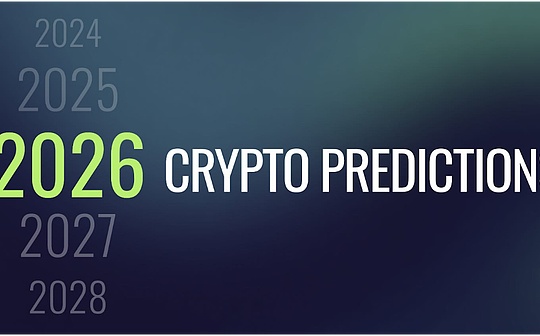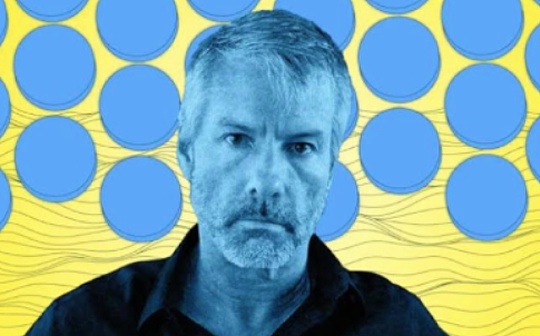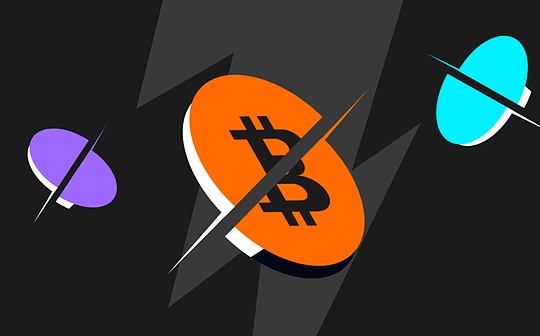
Author: Climber, Jessy, Cryptonaitive, Bit Chain Vision Realm
The currency circle one day, one year on earth.The fourth halves of Bitcoin’s completion of the historical process is a hundred years in a certain sense.
Bitcoin is based on four years of evolution, and every stage is refreshing the world’s cognition.From the initial payment currency, to value storage and digital gold, or the subversion and impact on the fields of sovereign currency and mainstream financial systems, they all questioned the mythical gains again and again.
As scientifically comes to Europe in the Middle Ages, theology is shrouded and obscure.But after all, you cannot stop the footsteps of the truth.Adam back, nick szabo, Satoshi Nakamoto, Hal Finney, Vitalik … A batch of evangelists goes forward, the pioneers benefit, and the believer is eternal.
Bitcoin is a virtual currency and a digital currency, but it may not be the Noah’s Ark when the financial tsunami hit.For this giant wheel, we might as well look at how it was built from the beginning.
1. What is Bitcoin halved?Why do you want to be halved?
1. Half at half
Bitcoin is halved, also known as “Halving”, which refers to a pre -coding event per 210,000 blocks set in the Bitcoin protocol (the cycle is about once every four years).The decrease of block refers to the process of reducing the number of digital currencies generated by the unit time, which is mainly achieved by reducing block rewards.
The supply of Bitcoin is limited to 21 million units. Once the total number is reached, the generation of new BTCs will stop.The decrease of Bitcoin ensures that the number of Bitcoin that can be mined each block will decline over time.By 2140, Bitcoin will be all mined, and the total amount is expected to be slightly lower than 21 million.
The process aims to control the issuance of new Bitcoin and maintain its scarcity, thereby ensuring that Bitcoin supply is limited.In essence, the mining will be reduced by half of the rewards to miners.
>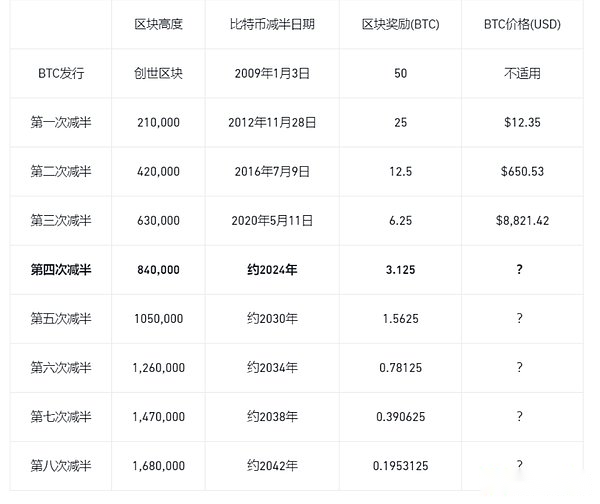
On April 20, Bitcoin decreased at half when the block height of 840,000, and the block reward after halving will drop from 6.25 Bitcoin to 3.125 Bitcoin.
Public information shows that the current miners bring about 900 bitcoin to the market every day.After halving, this number will drop to about 450 BTC.
Half -halving the influence, mainly because the incident usually leads to market fluctuations and increase speculation in the field of cryptocurrency; reshaping the mining format, the decline in profit points of miners; stimulating technological innovation and community development in the blockchain ecosystemEssenceHowever, the halving incident may also hedge inflation, which enhances the attraction of Bitcoin as a long -term investment asset.
2. Why is it halved?
Satoshi Nakamoto published Bitcoin White Paper on October 31, 2008, and the Bitcoin Creation Block was born on January 3, 2009.Half is to control the supply of Bitcoin in circulation. By reducing block rewards, the speed of entering the market for new Bitcoin will slow, which will help prevent inflation from inflation and ensure that the value of Bitcoin remains stable.
Half of April 20, 2024, the inflation rate of Bitcoin is expected to be reduced from approximately 1.75%to only 0.85%.
The reason why Bitcoin is born is mainly to consider that some countries will not limit the issue of currencies without limit. Nakamoto hopes that a currency will not be controlled by anyone.This point -to -point trading system.
The market supply and demand laws in economic theory show that if the number of circulation of a certain commodity is not limited, it will be prone to malignant inflation, and the price of goods will be greatly reduced.Conversely, when supply is reduced or demand remains unchanged or increased, the value of assets may increase.
>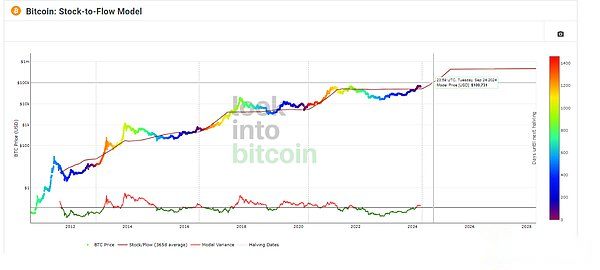
This reduction mechanism is also studied by the institution. The figure above shows the Bitcoin stock/traffic ratio model. This model studies the annual mining volume and total inventory, trying to predict the future value of Bitcoin.Backtime test proves that it can simulate the past price curve very accurately.
According to the conclusion obtained by the model, the scarcity of Bitcoin is the main driving force of the price.After clarifying the potential relationship of price and scarcity, the holder will realize the value of Bitcoin as a value savings tool.
From the point of view of the block, the bitcoin mining algorithm is programmed to find new blocks every ten minutes.As more miners join the network and add more hash computing power, the time to find blocks will be reduced.In order to restore the 10 -minute goal, the difficulty of mining is for about every two weeks.As the Bitcoin network has grown sharply in the past ten years, the average time of positioning blocks has been maintained at about 10 minutes (about 9.5 minutes).
A block of about 10 minutes in the Bitcoin network, a certain number of Bitcoin will be continuously dug out.Setting Bitcoin rewards at half of the 210,000 blocks can effectively reduce the inflation rate of Bitcoin, thereby preventing the occurrence of malignant inflation.
In 2009, Satoshi Nakamoto wrote: “From this perspective, Bitcoin is more like precious metals. It does not change the value of the supply by adjusting the supply volume, but set the upper limit of the supply in advance to make the value change.With the increase in the number of users, the value of each token will increase.”” “
2. Bitcoin is halved with bull market reincarnation
Market participants often minimize Bitcoin’s precursor of the bull market. This is because the price of BTC has reached a new high without exception after the previous three times.There are the same expectations.
Basically, when the miner adds a total of 210,000 blocks to the BTC blockchain, the BTC will be halved.After each BTC halved in the past, the price of BTC will continue to rise sharply for a long time.
Half of the schedule:
Half of the first (2012): The first Bitcoin halved occurred on November 28, 2012, and mining rewards decreased from 50 Bitcoin each block to 25 bitcoin.
The second halved (2016): The second halving on July 9, 2016 will further reduce block rewards to 12.5 Bitcoin.
The third reduction (2020): Among the third halving on May 11, 2020, the reward was reduced to 6.25 bitcoins per block.
The fourth halved (2024): In the fourth halves of the fourth time on April 20, 2024, the reward decreased to the 3.125 bitcoin per block.The future halving will continue until the maximum supply of 21 million Bitcoin is expected to be achieved in about 2140.
As of today, Bitcoin has been halved four times, and the industry is called a half -cycle.In the past, almost every time the BTC was halved, the price of BT would rise sharply.
>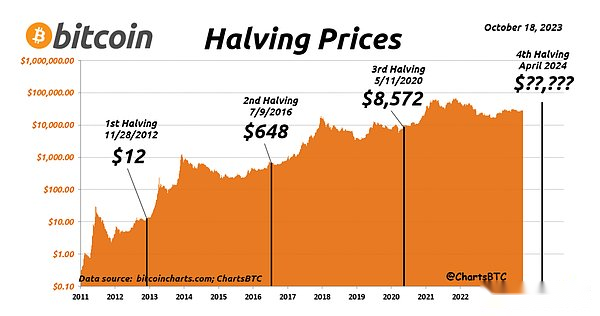
It can be seen from the figure above that since the birth of Bitcoin, its cycle cycle has been very stable.
The first half period: 2012.11.28-2016.07.10.The half -cycle caused two waves of bull markets in April and November 2013. The price of the first wave of bull markets rose from $ 12 to $ 288, the price increased by 2300%; the price of the second wave of bull markets from $ 66The price rose to $ 1242, the price increased by 1782%.
The second half-cycle: 2016.07.10-2020.05.12.The half -cycle caused a bull market in December 2017. The price of bull market in 2017 rose from $ 648 to $ 19,800, and the price increased by 4158%.
The third reduction cycle: 2020.05.11-2024.04.20.The half -cycle caused two waves of bull markets in April and November 2021. The price of the first wave of bull markets rose from $ 8572 to $ 69,000, and the price increased by 741%.The price of the second wave of bull markets rose from $ 15,476 to $ 73,777, and the price increased by 376%.Given the current Bitcoin price, the encryption market is still in the bull market.
Historically, the price of Bitcoin often fluctuates significantly before and after the reduction of the incident.In a few months before halving, the market’s expectations and guessing expected and guess that the price of future supply decreases may often promote the rise in prices.After a half -incident, Bitcoin usually experiences a significant bull market.
>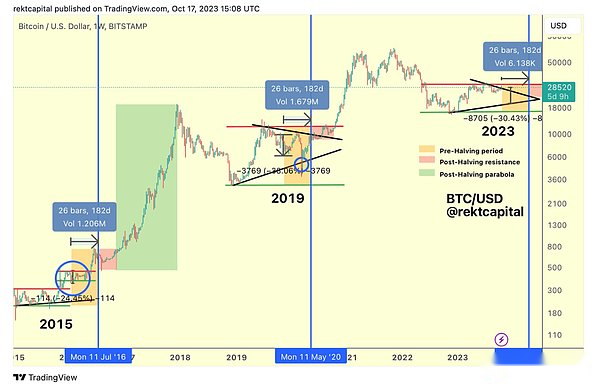
It can be seen from the above figure that before the BTC halved, the market will have a period of about 1.3 years of bear market.Since then, the market has reached its peak for about 1.3 years.In view of this, the market’s entire undulating process takes about 2.6 years.In addition, according to the BTC halving incident in the past, the BTC price bottomed out about 477 days before BTC.In addition, the average of 480 days from the peak of the off -half day to the peak of the next bull market cycle.
For example, after halving in 2012, the price of BTC rose from $ 12.25 to $ 127 within 150 days.Similarly, after half in 2016, the price of BTC rose from $ 650.63 to $ 758.81 within 150 days.In the end, after half in 2020, the price of BTC rose sharply from $ 8821.42 to $ 10,943.00 in 150 days.
At the same time, when reviewing the previous halving incident, Bitcoin will encounter a retreat.In 2016, the market experienced a sharp selling from about $ 760 to $ 540 before and after halving, with a callback rate of about 30%.In 2019, about 38%of the incident.
This year is still no exception. As of the end, the price of Bitcoin has been withdrawn by about 14%.
However, according to the Bitcoin inventory ratio model above, after the BTC halved in 2024, the price of BTC may rise to more than $ 100,000.Crypto research institutions PLANB and GlassNode both predict that BTC prices will rise in 2024 and exceed $ 100,000.Pantera Capital predicts that after the entire bull market cycle is over, the price of BTC will reach about $ 149,000 in 2025.
Historically, the Bitcoin cycle usually starts from 12 to 18 months after the peak of the bull market, and the new historical high has appeared a few months after halving.However, unlike in the past, the reduction of this reduction incident is accompanied by the development of the spot ETF in the United States Bitcoin, so the impact of the halved cycle of this round may weaken.
Investors also need to notice that the rise in bitcoin prices after halving is also related to major macroeconomic events.For example, in 2012, the European debt crisis highlighted the potential of Bitcoin as alternative value storage in economic turmoil, which led to its price rose from $ 12 to November 2013.
Among the first token issuance boom in 2016, more than 5.6 billion U.S. dollars were injected into the cottage, which indirectly benefited Bitcoin, rising its price from $ 650 to US $ 20,000 in December 2017.
It is particularly noteworthy that during the COVID-19 period in 2020, large-scale stimulus measures have exacerbated inflation concerns, and investors may be pushed to Bitcoin as risk aversion tools, resulting in its price rose from $ 8,600 to a rise to $ 8,600 to a rising to the $ 8,600 to the $ 8,600 to the rise to the $ 8,600 to the $ 8,600 to the $ 8,600 to the rise to the $ 8,600 to$ 69,000 in November 2021.
The above information shows that although the decrease will help strengthen the scarce narrative of Bitcoin, macroeconomic factors will also have a significant impact on Bitcoin prices.The risk of the encryption market is high, and investors should be treated more cautiously.
3. BTC epic
In order to grasp the encryption cycle caused by the reduction of each round of Bitcoin, it is necessary to review the epic of Bitcoin’s development.
Just like countless great things, Bitcoin is not produced out of thin air, and it stands on the shoulders of his predecessors.
It requires both technical reserves and ideological reserves.
Technical reserve before Bitcoin was born
The birth of Bitcoin needs to first obtain technical breakthroughs in cryptography and digital currencies.
Demonstration of asymmetric encryption in 1976: November 1, 1976 Codemologist Whitfeld Diffie and Martin E. Hellman published the papers “New Directions in Cryptography”.(The same keys for encryption and decryption) Enter asymmetric encryption.This innovation paved the road for a safe digital signature, and achieved public key and private keys in encryption transactions, becoming an indispensable part of the Bitcoin function.
1977 RSA algorithm: One of the earliest public key password systems, Ron Ron Rivest, ADI Shamir and Leonard ADLEMAN’s first letters.
1989 DIGICASH: David Chaum founded Digicash, which is one of the first attempts designed to fully anonymous and safe digital payment systems.DIGICASH is based on blind signing technology and is based on public key and private keys.Despite the use of innovative methods, it has caused its failure due to a centralized model.But Digicash is an important pioneer in the development of cryptocurrencies such as Bitcoin.
With the development of the Internet, the hot period of digital currency innovation was ushered in the end of the 1990s to the beginning of the 20th century.
E-Gold (Digital Currency) in 1996: E-Gold is a platform created by Douglas Jackson and Barry Downey, allowing users to transfer gold ownership by electronic ways.The heart structure has become the focus of legal challenges, especially in terms of money laundering.This combined with the security issue, which leads to its ultimate dissolution.
In 1997, Hashcash (workload certificate): Adam Back invented Hashcash in 1997 and proposed the workload certificate system.Hashcash is a workingload mechanism for preventing junk emails and refusing service attacks.The principle of workload proof was later introduced into the Bitcoin consensus mechanism.
1998 B-Money (distributed ledger): Chinese Chinese scientist Dai Wei proposed the B-Money electronic currency agreement. B-Money was imagined to be a decentralized and anonymous electronic cash system.Save all transactions copy to ensure collective and transparent verification.This protocol is the prototype of a distributed ledger. When Nakamoto created Bitcoin, B-Money was cited.
Bit Gold in 1998: NICK SZABO invented Bit Gold, which was grateful by the real world gold mining process and introduced the workload certificate.Bit Gold requires participants to show the work certificate to create a new currency unit called “Bit”.Once this work is verified, the new “Bit” will be added to a chain, linking it to the previous Bit link, forming a public and anti -tampered record.And proposed the Byzantine algorithm to prevent double flowers.This system is the first prototype close to the Bitcoin architecture.Although Nick Szabo elaborates the principles of Bit Gold in detail, it has never fully developed or launched a comprehensive operating model.
2004 RPOW (Repeated workload certificate): Hal Finny was developed by HashCash, Hal Finny believes that RPOW can be used as the basis, Promote POW token as the use of P2P electronic cash.This is why Ben Cong was interested in Bitcoin from the beginning when Bencong shared Bitcoin White Paper in the password punk mail list.Hal Finny was the first person to run the Bitcoin node, the first miner, and the first receiver of Bitcoin transactions.
Satoshi Nakamoto’s ideological reserves and Bitcoin Zhaoqi
The currency problem has always been thoughtful.If currency is the crown of social science, the business cycle is the gem of the crown of social sciences.
During the classical period, countless sociologists such as Kanjilong, John Lao, Hume, etc. have all thought about the origin of inflation and the pursuit of solid currency (Sound Money).
After entering modern times, in the process of pursuing the explanation of the capitalist economic crisis and the business cycle, a school of economists, the Austrian school, was born.The Austrian School believes that inflation is mainly a currency phenomenon, which is the inflation caused by the addition of credit currencies, which in turn distort market price signals, so that companies in the market will make mistakes in errors, until the market liquidation is the economic crisis.
After entering the 20th century, as the credit age, especially the central bank’s step -by -step, large, inflation caused by fiat currency is ultimately like a tiger to return to the mountain.Humans have witnessed countless malignant inflation, such as German Mark and the Kuomintang gold coupon.
There are also great brings in the United States, which starts with the Grand Depression in 1929.Because the central bank’s fiat currency is afraid of the competition of Sound Money.During the Great Depression, the US President Roosevelt issued administrative orders No. 6102 on April 5, 1933, banning the American people from having gold.Until 1975, the 6102 administrative order was abolished.
Nakamoto must be familiar with the black history of the United States.Perhaps this is why Nakamoto entered April 5, 1975 as the birth date when he registered the pseudonym of the P2P Foundation.
In 1974, the Austrian school economist Hayek obtained Nobel Economist and published “non -nationalization of currency” in Hayek in 1976.Coupled with the criticism of the US Monetary School Friedman’s criticism of inflation in the 1980s and 1990s, as well as the revival of the Austrian school promoted by the Liberal Party and the American Liberal Party, in the United States.
Looking back, if Satoshi Nakamoto grew in the 1980s and 1990s, he would inevitably be affected by the Austrian School of Economics and accepted its currency claim “The Seperation of Money and State”.
After the test after the previous section of Adam Back, Dai Wei, Nick Szabo, Hal Finny and others, Nakamoto began to stand on their shoulders, comprehensively the director of each family, and made an original contribution.
In early 2007, Satoshi Nakamoto began to write code for Bitcoin.A Cong Satoshi wrote an article in the password e -mail list on November 17, 2008: “I believe that in the past year and a half, I have solved all these small details when writing code.”
Then in 2008, the financial crisis that shocked the world in 2008.The financial crisis allows people all over the world to think about business cycles and inflation.
In this crisis, both Satoshi Nakamoto and Human beings were ready.
Bitcoin Development Event
August 18, 2008, registered Bitcoin.org domain name: The domain name “bitcoin.org” is registered by a person with unknown privacy protection services.The person’s identity is still unknown, but many people think he is Nakamoto Nakamoto, the creator of Bitcoin.The website is the central hub of Bitcoin information, including the beginner guidelines, technical documents, and news and updates related to the Bitcoin ecosystem.The domain name is currently maintained by the open source community.
On October 31, 2008, Satoshi Nakamoto published a Bitcoin white paper “Point -to -Point electronic cash system“: The most important contribution of Bitcoin White Paper is to solve the problem of double -flower problem through the so -called blockchain through the decentralization mechanism. Blockchain is a distributed public ledger that records all transactions in a safe and transparent manner.Relying on POW network to verify the integrity of transactions and maintain the integrity of the blockchain.
On January 3, 2009, Satoshi Nakamoto mined Bitcoin Creation Block on a server in Helsinki: The Creation Block contains a message in the CoinBASE parameter. The content is as follows: “The Times, January 3, 2009, the Financial Minister is about to provide a second rescue to the bank.” This is the headline news of the Times that day, the Times,It is reported to the British government’s plan to assist the bankruptcy bank.
On January 12, 2009, the first BTC transfer: Nine days after the launch of the Bitcoin Network, Satoshi Nakamoto sent 10 Bitcoin to Hal Finny’s Bitcoin address.
In February 2009, the first Bitcoin wallet Bitcoin-QT: Its user -friendly interface allows early Bitcoin users to create and manage digital wallets to send and receive Bitcoin.Starting from version 0.9.0, Bitcoin-Qt was later called the Bitcoin Core wallet.
On March 17, 2010, the price of bitcoin recorded for the first time in history: Bitcoin recorded a price of $ 0.003 for the first time on the currently dissolved Bitcoinmarket.com.
On May 2, 2020, the first bitcoin transaction was born: LASZLO HANYECZ purchased two sticks of John Pizza with 10,000 Bitcoin, and the value of these 10,000 Bitcoin was only a few dollars.
On December 12, 2010, the last article of Satoshi Nakamoto: Nakamoto published the last article on Bitcointalk.org. He added some DOS restrictions and deleted the previously introduced alarm system security mode.
On July 18, 2010, programmer Jed McCaleb founded MT.GOX: MT. GOX was originally a project initiated by a programmer Jed McCaleb. He purchased a domain name of mtgox.com in 2007 to create a platform for game Magic: The Gathering virtual card transaction.By 2010, MCCALEB re -applied the domain name as a Bitcoin Exchange. Less than a year after the platform was established, he sold the platform to French -born developer Mark Karpelès.About 70%of Bitcoin transactions.
On November 1, 2010, the Bitcoin logo was born: An unknown artist was created in the name of “Bitboy”. To this day, “Bitboy” status is still unknown.
In February 2011, the Silk Road was launched
In June 2011, the first bitcoin bubble: Although Bitcoin was born in 2008, it was not until 2011 that the price began to soar.In early 2011, the transaction price of Bitcoin has been lower than $ 1 per each, but by June 2011, the price of each bitcoin has risen to more than $ 31.However, 25,000 Bitcoin was stolen due to the MT. GOX exchange due to large -scale hackers, and Bitcoin prices had fallen to $ 2 in November 2011.
In June 2011, the first bitcoin hacker attack: ALLINVAIN posted on the Bitcointalk Forum that someone invaded his computer and stole 25,000 bitcoin directly from his hard disk.The value is about $ 500,000.
On June 20, 2011, MT. GOX was hacked for the first time: In June 2011, MT. GOX experienced the first major crisis. Hackers aimed at the exchange and used vulnerabilities to make the price of Bitcoin on the platform plunged from US $ 17 to only beauty in a few minutes.A leaked MT. GOX file shows that hackers have stolen Bitcoin from the exchange for many years, causing more than 850,000 bitcoin to disappear.
On April 18, 2011, the first copycat Namecoin was born: Namecoin is a cryptocurrency and decentralized domain name system (DNS). It is a bifurcation as a Bitcoin protocol. It has some similarities (including the use of workload proof mechanisms).The centralized and anti -review system is used to register and manage domain names, as well as storage and transmission of any data.
On November 18, 2012, Bitcoin fell for the first time: For the first time in Bitcoin, the incident occurred at a block height of 210,000, and block rewards were reduced from 50 Bitcoin to 25 Bitcoin.
On May 2, 2013, the first Bitcoin ATM machine was installed in Vancouver, Canada
On March 18, 2013, the market value of Bitcoin exceeded $ 1 billion for the first time
On July 3, 2013, the first ICO: Mastercoin’s first token issuance (ICO), ICO participants sent Bitcoin to the specified address, as a return, received the newly created MasterCoin tokens MSC.This method shows the potential of tokens as a blockchain development and financing method, and sets a precedent for countless ICOs.Mastercoin later changed its name to Omni.
On December 18, 2013, HODL was born:A user published a post entitled “I am in Hodling” on the Bitcointalk.org forum.This spelling error later became a popular term.
On February 25, 2014, MT. GOX applied for bankruptcy protection: Due to hackers, it lost 850,000 Bitcoin, which was worth about $ 450 million at that time.
In the whole year of 2015, Bitcoin expansion and block size issues: Two expansion conferences, the Scaling Bitcoin Montreal in September, and the Scaling Bitcoin Hongkong in December.
On January 14, 2016, the Lightning Network White Paper was released: Joseph Poon and THADDEUS DRYJA released the Lightning Network White Paper. Lightning networks are paid under the status channel chain to speed up the transaction time, thereby providing expansion solutions for Bitcoin.
On July 9, 2016, Bitcoin fell half of the second time: Bitcoin’s second halved occurred at the block height of 420,000, and block rewards dropped from 25 Bitcoin to 12.5 BTC.
August 1, 2017 BCH bifurcation: Bitcoin’s block size is limited to 1MB (because Segwit is upgraded to 4MB), and BCH’s block size is limited to 32MB.
On August 23, 2017, isolation witnesses SEGWIT activated at the height of Bitcoin’s main network 481,824: SEGWIT aims to solve several long -term problems of Bitcoin, such as transaction ductility and scalability.In terms of scalability: By separating the testimony from the transaction, the block size is effectively raised to 4MB, so that each block is allowed to contain more transactions.Segwit also improves the security of bitcoin transactions by solving certain vulnerabilities (such as transaction ductility).SEGWIT’s activation marks the end of the Bitcoin block size.
In November 2017, the Lightning Network launched the Bitcoin main network and completed the first transactionEssenceRefer to the previous article of Big Chain Vision “Interpretation of Lightning Network Principles“” “.
In November 2017, Zhishang Institute officially launched Bitcoin futures transactions, and Bitcoin rushed to a high level of $ 19,000.
In January 2018, the legendary character Lazlo Hanyecz successfully purchased pizza again through the lightning network.
In January 2019, Lightning Torch Event
On March 12, 2020, affected by the new crown epidemic and U.S. stocks, Bitcoin plummeted and fell to less than $ 3,800.
On May 25, 2020, Bitcoin fell for the third time: The third reduction of Bitcoin occurred at the block height of 630,000, and block rewards were reduced from 12.5 Bitcoin to 6.25 bitcoin.
In January 2021, Stacks launched: Stacks was originally called Blockstack, which was co -created by Muneeb Ali and Ryan Shea.This layer has its own programming language Clarity and a consensus mechanism called the transmission proof (POX), which together allows the execution of smart contracts on the Bitcoin blockchain.
On February 8, 2021, Tesla announced that Bitcoin payment was acceptable
On February 19, 2021, the market value of Bitcoin exceeded $ 1 trillion
In April 2021, the price of Bitcoin reached $ 65,000
In June 2021, China banned Bitcoin mining, Bitcoin fell below $ 30,000 for a time, and the Bitcoin computing power moved to the United States
On September 7, 2021, Bitcoin became the legal currency of Salvador
On November 14, 2021, Taproot upgraded and activated: This is the biggest improvement after Bitcoin’s 2017 SEGWIT activation. The Taproot upgrade introduced the SHNORR signature and smart contract function improvement.Refer to the previous article of Big Chain Vision “What is taproot“” “.
In November 2021, the price of Bitcoin reached the last round of ATH 69,000 US dollars
In December 2022, the ICP main network integrated Bitcoin
In 2023, Bitcoin Ecological Development New Year: Ordinals, INSCRIPTIONS, BRC20, Atomical, ARC20, Bitstamp, SRC20, RUNE, TAPROT AsSETS, RGB and other new concept layers have emerged. The development of 2023 is the sum of the previous years of development.Refer to the previous article of Big Chain Vision “Bitcoin Ecology 2023 inventory“” “.
In January 2024, the US SEC approved 11 Bitcoin spot ETFs.
In March 2024, it was stimulated by Bitcoin spot ETFBitcoin price rose to $ 73,000, Breaknight before halving before halving.
Since 2024, the rise of Bitcoin Layer 2.According to statistics from Bitchain Vision, there are currently availableMore than 50 Bitcoin L2.
Fourth, there are talented people from Jiangshan
With the development and evolution of Bitcoin and the cycle of the encryption cycle, the leaders of the encrypted industry have also been updated.It can be described as a talented person in the Jiangshan Dynasty, and each leading the show for a year or two.
Here are the leaders who are constantly changing in the history of encrypted development.
Satoshi Nakamoto: The creator of the Bitcoin Agreement and its related software Bitcoin-QT. The real name is unknown. He claims to be Japanese Americans. In 2009, he released the first Bitcoin software and officially launched the Bitcoin financial system.In 2010, he gradually faded out and handed over the project to other members of the Bitcoin community.
Vitalik buterin: The rivers and lakes are called V God, the founder of Ethereum.When he first exposed to cryptocurrencies, he was also a fan of Bitcoin. He founded the Bitcoin Magazine in 2011. At present, the most comprehensive Bitcoin Python library is the Pybitcointools he wrote.Vitalik is a supporter of the Bitcoin block. It first wanted to make Bitcoin into a scalable thing, such as the color coin with his team, which supports users to issue coins in the BTC ecosystemAnyone can build assets based on the Bitcoin agreement and conduct transactions.Ethereum inherits the idea of large blocks, which is different from the digital gold of Bitcoin, but a “computer”.
Ao Ben Satoshi: Formerly known as Craig Steven Wright, the founder of BCH’s fork coin BSV, Australia, a person who claims to be Satoshi Nakamoto.Its famous noise was because in 2016, he claimed to be Satoshi Nakamoto, and even received the confirmation of Gavin Anderson, a member of the core team of Bitcoin.But later because Australia could not provide sufficient evidence, he finally gave up, but got the title of “Australia’s Satoshi”.
In the Bitcoin bifurcation storm, Ao Benci was also very active, and even threatened to destroy the Bitmain with money and money, and finally BCH was split, BSV was born.
Long -term: Real name Liu Zhipeng, the founder of China’s largest blockchain forum, the media “Babit”, and a science fiction writer.He has a significant role in the Chinese blockchain world. He has long been committed to the promotion and theoretical research of blockchain technology for a long time. He is the presence of the “impossible triangle” theory of the blockchain.A real and illusory financial world.
Grill: Real name Jiang Xinyu, another unrealized name in the history of Bitcoin development.He is the first person to successfully release the ICO project in the Bitcoin circle of China. It is also one of the earliest talents in China to manufacture ASIC mining machine technology. It had a net worth of 100 million as early as 2013 and held 20%of the computing power in the entire network.From the end of 2014 to the beginning of 2015, it suddenly lost contact and never appeared.
Wu Jihan: Mining, the founder of Bitmain, at the highest computing power of Bitcoin mining at the highest time.In 2017, in the dispute between Bitcoin’s large blocks, it supported large blocks, and then fork Bitcoin, BCH was born, and even wanted to usurp power BTC.
Li Xiaolai: It was originally a New Oriental teacher and was known as the richest man in China Bitcoin. He first purchased Bitcoin in 2010, and decisively added positions in the bear market in 2014.At this point, 100,000 Bitcoin accumulated on his hand.In 2017, Li Xiaolai made all Bitcoin cash, earned about 13.5 billion yuan, and publicly said that Bitcoin was a scam.
CAsey Rodarmor: Developers of the Ordinals protocol have allowed NFT to be realized on Bitcoin. This is another try to issue NFT on Bitcoin since Bitcoin’s colored coins appeared in 2012 and derivatives in 2014.Later, he proposed the Rune Agreement, which will be launched on the fourth time Bitcoin.
Bellaide CEO LARRY FINK: As early as 2017, FINK stated that he was the “loyal believers” of cryptocurrencies. In 2023, Berlaide submitted a Bitcoin ETF application. FINK said that cryptocurrencies are expected to surpass global currencies.This move of the global financial giant is undoubtedly the mainstreamization of Bitcoin into a psychic agent. Later, Berlaide did become the first batch of people in the United States to eat Bitcoin spot ETF crabs.
Salvador President Nayib Bukele: He is the first president in the world to openly support Bitcoin, and has made Bitcoin a legal currency in its country. Since then, the country is buying a bitcoin every day.This is undoubtedly an innovative attempt to the current financial system.
CEO of MicroslategyMichael Saylor: Michael Saylor is the company with the most Bitcoin in the position, and Michael Saylor is also one of the important characters in the cryptocurrency field. It is said that he holds more than 120,000 Bitcoin.
Zhao Changpeng: The founder of Binance, in 2014, used the money sold for $ 600 to shuttle Bitcoin.It established the current largest trading exchange in 2017, and its consequences of the Qing retirement exchange selected the development direction of globalization.It turns out that decisive going to the sea has indeed achieved Binance.However, it was also trapped in a lawsuit with the US government.
The industry has always praised Zhao Changpeng in the industry that it is not just an exchange.Binance Investment has hatched many projects, and has been working hard to make the industry’s cake bigger.
In the history of Bitcoin’s development, countless people have come and again, and some people have always insisted on, from early evangelism to the front -line participation in industry construction.The history of encrypted development will remember those who are actively engaged in, and their faith in Bitcoin also gives them a rich enough wealth return.
5. From paying currency to digital gold, no governmentism is finally collected
Since 2008, Bitcoin has been born for almost 16 years.After Bitcoin was born in 2008, after the financial crisis of 2008, Nakamoto faced the inflation caused by currency super -issuing, and wanted to create a financial system independent of the country.At the beginning of the founding, Bitcoin was an electronic cash. Nakamoto originally hoped that he could be used by people like currency.
However, in the first two years, Bitcoin was almost worthless.The price of a bitcoin is less than half ae, and no merchant is willing to accept Bitcoin.It was not until May 2010 that Bitcoin was used to buy food.A early miner Laszlo Hanyec replaced two pizza with 10,000 Bitcoin.
Since then, Bitcoin has really gained extensive practice as a payment method, which is on the dark network.In 2011, the dark network Silk Road was established, and Bitcoin became a hard currency on it. In addition to its anonymity, it was largely due to its difficulty to track the needs of the dark web.
From the early data, it can also be found that 30%of the transactions in the first three years of Bitcoin were directed at the dark network; by 2014, the average daily Bitcoin transaction volume of the six dark networks reached $ 650,000 per day.Money laundering, drug trafficking, and trafficking women and children, Bitcoin is bound to these words.According to statistics, as of January 2018, about 25%of Bitcoin users and nearly half of Bitcoin transactions are related to illegal activities.
Some dark webs have disappeared, and the most commonly used virtual currencies for money laundering have also changed from Bitcoin to TEDA, because their prices are constant.As the price of Bitcoin rises and the price fluctuates greatly, Bitcoin’s function of exchange currency is gradually weakening, and it has become a tool for value storage.Bitcoin firmly strengthened the positioning of digital gold, and in practice, Bitcoin is constantly making this position.
With the collapse of some sovereign countries’ currency systems, Bitcoin has become a choice for people to surpass fiat currency in some countries.
In September 2021, Bitcoin became the legal currency of El Salvador’s circulation.Salvador has also become the country of Bitcoin.
The new president of Argentina promotes the benefits of Bitcoin and cryptocurrencies in multiple public places.The Argentine people who have been inflation for a long time are also actively buying Bitcoin.Argentina is one of the countries with the highest use of cryptocurrencies around the world.Inflation data shows that Argentina’s inflation rate rose from 254.20%in January 2024 to 276.20%in February.
It can be seen in the above -mentioned examples that Bitcoin is indeed playing the role of anti -inflation that Nakamoto’s initial imagination.However, some sovereign countries are indeed actively embracing Bitcoin, but the original intention of that independent of the mainstream financial system can no longer be realized.Today, some governments are actively supervising and embracing Bitcoin, and Bitcoin has become part of the mainstream financial system.The most direct manifestation is that some countries have passed the spot ETF of Bitcoin, especially the passage of the United States, which has a profound impact.
Looking at the development of Bitcoin in recent years, we can see that in fact, Bitcoin has slowly changed from payment to gold -like investment products, and countries have also been cracking down on their attitudes to it.Embrace.
Earlier, Bitcoin was a bunch of great guests. After nearly 16 years of development, Bitcoin’s narrative has also changed from paying currency to digital gold. From a confrontation against the national financial system, it was finally being mainstream financial system.Posted.
The Bitcoin itself is also changing. There have been large -scale disputes, forks, and new gadgets such as inscription runes above them.
Forces of all parties staged various disputes on Bitcoin for their own interests, but these have not really shaken Bitcoin, and Bitcoin is still great.

